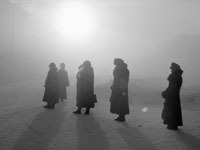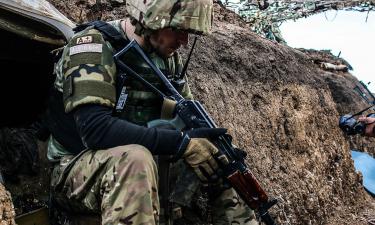Vorkuta: Horror oа Gulags, beauty of polar nights
 The city of Vorkuta has a sad reputation in Russia. It is known as a city of concentration camps and criminals. The residents of Vorkuta call their hometown "the polar steamshop." The city has another nickname - "the capital of the world." Vorkuta is a city of contrasts. There are many things in the city that remind you of Stalin's Gulags. Vorkuta is also known for the beauty of its tundra, severe climate and the warmth of the human heart.
The city of Vorkuta has a sad reputation in Russia. It is known as a city of concentration camps and criminals. The residents of Vorkuta call their hometown "the polar steamshop." The city has another nickname - "the capital of the world." Vorkuta is a city of contrasts. There are many things in the city that remind you of Stalin's Gulags. Vorkuta is also known for the beauty of its tundra, severe climate and the warmth of the human heart.
Journalist Vladimir Ilyin called Vorkuta "the city of concentration camps" in his book "Power and Coal." According to him, the spirit of concentration camps in the city was everywhere in spite of the fact that many former prisoners had left Vorkuta.
"Everyone who comes to Vorkuta dives into the Gulag atmosphere. Barracks against the background of Stalin's Empire style, the cult of power and universal hostility. The language spoken by all residents of Vorkuta, even intelligentsia, has always been abundant with jargon and profanities," the journalist wrote.
Everything that Vladimir Ilyin wrote is true. But this is a reality of the post-Soviet Vorkuta. Nowadays, the majority of local residents will not use foul language if there is no need for it. They will not refer to their hometown as the city of concentration camps either. The people love their town and invite everyone to visit the city that was built in permafrost.
Vorkuta was built as a village of barracks. The word "vorkuta" translates from the Nenetsky language as "bear corner." Summer is very short in the region, whereas winter lasts for eight months. The soil of the tundra is never soft - it remains frozen all the time.
There is a memorial cross on the right bank of the Vorkuta River. The cross marks the place, where Soviet geologists discovered charcoal. The Geologists built a camp on the location on June 25, 1931. The majority of them were Gulag prisoners. The first settlement was called Rudnik. This is the place that started the history of Vorkuta.
Heroism was next to tragedy in that place. The people had to spend the first winter living in dugouts and tents. The settlers would suffer from frostbite and scurvy every now and then. There were 1,500 villagers in the beginning, but only 54 people survived two polar winters.
The first coal mine in Vorkuta produced its first thousand tons of coal in 1931. The coal would be transported from the village of Rudnik to the seaport via a narrow-gauge railway. The railway still exists, although it was abandoned a long time ago. It was the first railway in the world that was built 160 kilometers from the Arctic Ocean.
The year 1933 became a discovery for the Soviet aviation and a day to remember for Vorkuta. A plane landed in the settlement of Rudnik. Passenger and cargo flights were later carried on a regular basis.
First buildings appeared in the town in 1941. The buildings were made of wood - they were the masterpieces of wooden architecture. Some of them were even included in the Great Soviet Encyclopedia. Only two of those buildings have been preserved today. The first street that appeared in the town was named after Vladimir Lenin, of course. Vorkuta officially became a town on November 26, 1943.
Many people found themselves in Vorkuta against their own will. They were the people from the countries of the former USSR and other countries of the world. That is why Vorkuta is known as the capital of the world.
Artur Priymak
Pravda.Ru
Subscribe to Pravda.Ru Telegram channel, Facebook, RSS!





